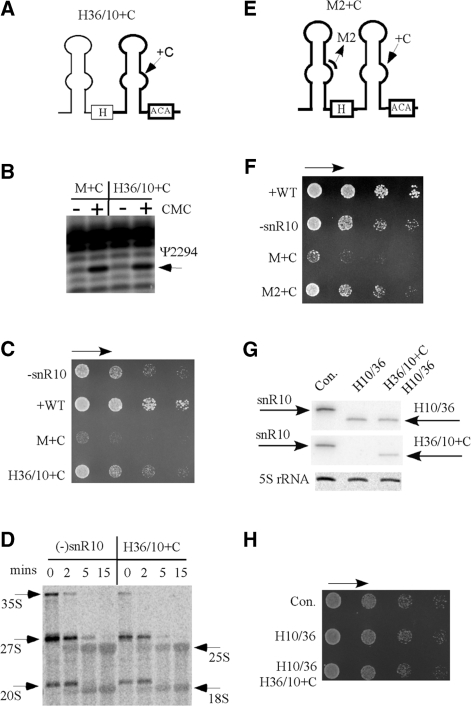Figure 9.
The severe growth defect caused by the C-insertion mutation is not due to mis-targeting of the Ψ modification. (A) Construction of a hybrid snoRNA with the mis-targeting guide domain from snR10 (H36/10 + C). The mutant snoRNA includes the 5′ hairpin of snR36 (thin line) and 3′ hairpin of snR10 (thick line) with the C-insertion mutation. (B) The levels of Ψ modification at the novel site are similar for both the novel hybrid and the initial snR10 variant with the C-insertion mutation (H36/10 + C and M + C), as shown by primer extension data. (C) The hybrid snoRNA with the C-insertion in the guide domain causes moderate growth defects similar to those seen for snR10 depletion. (D) Similar moderate defects in processing are also apparent for the hybrid snoRNA with the C-insertion mutation and for the snR10-depletion condition. (E) Structure of a double mutant of snR10 that includes changes in both the processing and modification hairpin domains (M2 + C). The changes are: substitution mutations in segment 2 of the 5′ hairpin, and the C-insertion in the guide region in the 3′ hairpin. (F) A 4-nt substitution in the 7-nt processing element suppresses the growth defect caused by the 3′ C-insertion mutation. (G) Co-expression of hybrid snoRNAs H10/36 and H36/10 + C in snR10-depleted cells. Total RNA was analyzed by northern hybridization using probes specific to the 5′ half (upper panel), or the 3′ half (middle panel). 5S rRNA was used as a control for loading. (H) No growth defect resulted from co-expression of the H10/36 and H36/10 + C snoRNAs.

